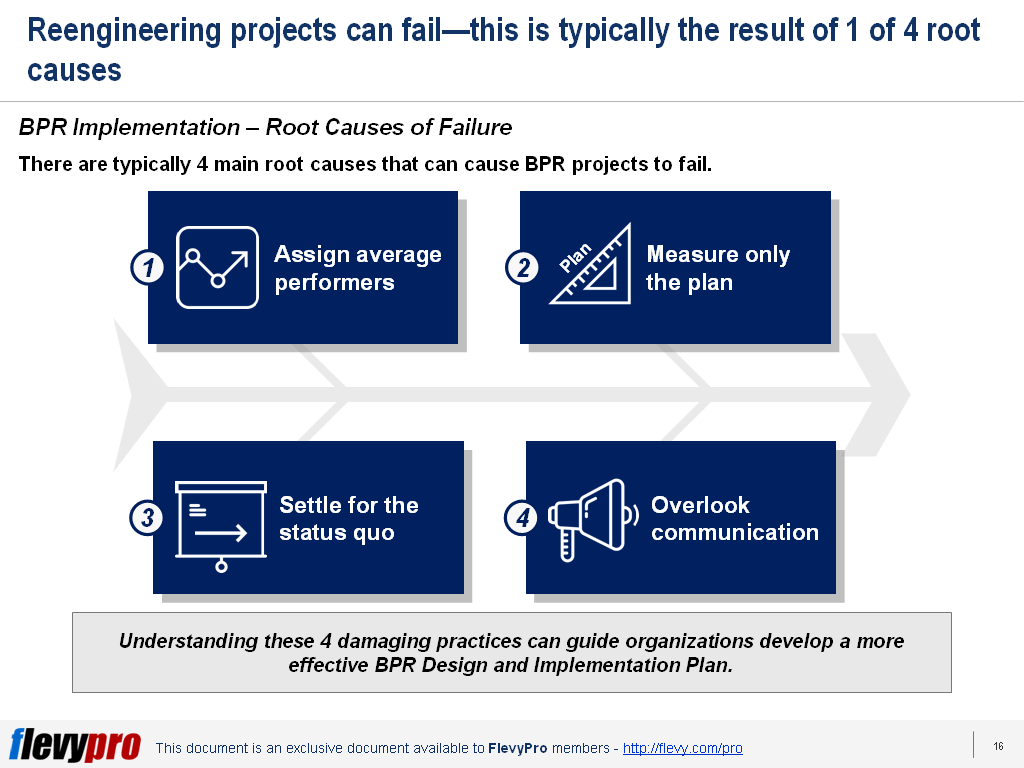Business Process Reengineering (BPR) can be a great success but it can also be a great failure.
After months or years of careful redesign, organizations can achieve dramatic improvements in individual processes. However, a paradoxical outcome has become almost a commonplace. Organizations suddenly find themselves watching the overall results decline. Process costs were reduced by 34% yet operating income stalls. Claims process time cut by 44% yet profits drop. It seems that organizations are squandering management attention and other resources on projects that look like winners but fail to produce bottom-line results for the business unit as a whole.
Reengineering can actually deliver revolutionary process improvements and many organizations have been undertaking major reengineering effort. However, like any major change program, a reengineering project can produce lasting results only if it is designed and implemented the right way.
Implementing Business Process Reengineering
BPR implementation is a series of waves that can wash over the organization for years, leaving a system for continuous improvement. It must be undertaken with a clean slate approach to process design. Only then can companies avoid a classic reengineering pitfall of focusing on fixing the status quo.
Implementation of the Business Process Reengineering requires that new infrastructures are planned and built to support this Business Transformation. The full commitment of senior executives on its redesign and implementation must also be present to ensure the success of the reengineering project.
It is essential that organizations have a good understanding of the success factors, as well as root causes of failure. While reengineering projects can succeed, it can also fail. There are 4 practices that are the most damaging.
The 4 Root Causes of Failure
The root causes of failure remain a challenge for organizations. These are 4 causes they must watch out for to achieve a successful BPR implementation.
- Assign average performers. This is the tendency of organizations to enlist average performers from headquarters. This often happens because of an existing belief that assigning top performers will affect the business unit’s performance.
- Measure only the plan. Measuring only the plan happens when there is a lack of a comprehensive measurement system. The organization also fails to track whether the implementation is succeeding or failing.
- Settle for the status quo. Settling for the status quo is a very deadly decision or reaction. When this happens, aspirations are never translated into reality. There exists the inability to think outside existing skill levels, organizational structure, or system constraints. Further contributing to this is the existence of political infighting on incentives and information technology during implementation. When this exists, often the decision is to maintain a status quo that could be debilitating to the organization.
- Overlook communication. During BPR implementation, there is a tendency to overlook communication. Probably due to a lack of proper understanding, the level of communication is underestimated during implementation. Often, communication is done using memos, speeches, or PR videos. While these may have its purpose, at times these methods can be limiting.
BPR implementation requires a small group format where employees can give feedback and air their concerns. This may be time-consuming but it is important. In fact, organizations must create a comprehensive communication program that uses a variety of methods of communication. When this is undertaken, the chances of succeeding during the BPR implementation is high.
BPR implementation is most crucial. Hence, organizations must have a keen eye, as well as strong leadership development and commitment, to pursue it despite its challenges. BPR implementation is a series of waves that can wash over the organization for years. Hence, a system of continuous improvement must be in place.
Interested in gaining more understanding of Business Process Reengineering (BPR) Implementation Guidelines? You can learn more and download an editable PowerPoint about Business Process Reengineering (BPR) Implementation Guidelines here on the Flevy documents marketplace.
Are you a management consultant?
You can download this and hundreds of other consulting frameworks and consulting training guides from the FlevyPro library.
Comments